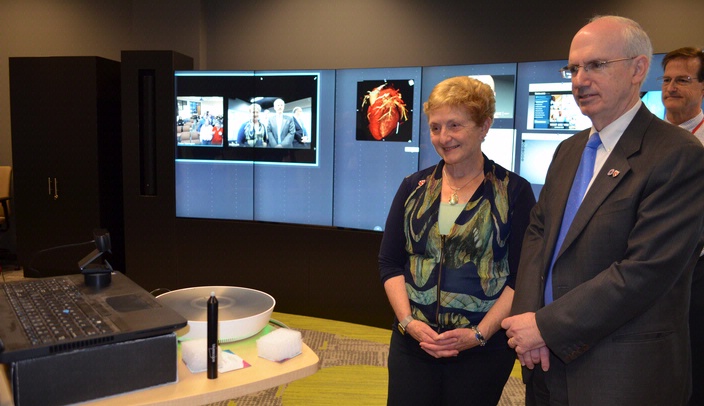First there were chalkboards, then overhead projectors, 35mm slides, Powerpoints and SMART Boards. Now the University of Nebraska Medical Center is moving into much more sophisticated technology for education and research, including the Interactive Digital iWall, 3D technology and augmented and virtual reality.
When the Dr. Edwin Davis & Dorothy Balbach Davis Global Center for Advanced Interprofessional Learning opens in Omaha next year, the latest technology will engage learners with hands-on simulated experiences designed to make learning highly realistic to improve human performance and effectiveness in health care.
Yesterday, a demonstration of the iWall with new MT Canvus software showed the possibilities of collaborating across distances with multiple participants. It enables new ways of thinking and allows users to present content in real time, transforming collaboration and communication. The iWall is a 2D-curved interactive “wall.”
Representatives from MultiTaction and AVI-SPL stationed representatives in the Sorrell Center Visualization Hub in Omaha and in Scottsbluff at the college for a first-of-its-kind demo. Pete Malcolm, CEO of MultiTaction based in London, demonstrated what's possible using the iWall, including using and sharing graphics, photos, video and other resources like websites.
In Scottsbluff at the UNMC College of Nursing West Nebraska Division and Western Nebraska Community College, a three-panel demonstration interactive digital iWall was connected to the 12-panel iWall in the iEXCEL Visualization Hub at UNMC in Omaha. The 12-panel iWall stands 8 feet high, 28 feet wide and 4 ½ feet deep.
Participating were the UNMC iEXCEL team, UNMC and Nebraska Medicine faculty, staff, and students in Omaha and Scottsbluff. In each location, participants could see each other as well as view, manipulate and share information live via the iWalls. Students also contributed information and manipulated images on the iWall through personal computers.
The number of participants who can use the iWall is only limited by the size of a network and literally hundreds of participants can interact with the walls at the same time, said Malcolm.
The UNMC colleges of nursing, dentistry and allied health professions are considering investing in the interactive walls that show much promise of developing new ways of teaching and learning.
"We're grateful for the opportunity to see how this works and are excited about it," said Sue Wilhelm, Ph.D., assistant dean of the UNMC College of Nursing West Nebraska Division. "It worked perfectly. I'm so impressed. I will be interested to see how it's integrated into curriculum."
"It was a spectacular demo," said UNMC Chancellor Jeffrey P. Gold, M.D. "It will help us build the iEXCEL model as we begin our journey into visualization and virtual reality. To me, it's simply a tool driven by what students need.”
Dele Davies, M.D., vice chancellor for academic affairs and dean of graduate studies, said the demo of the MultiTaction wall in Scottsbluff is a significant step forward in enabling multisite interactive learning.
“Multiple participants from sites no matter how remote can view, annotate and make changes to the same presentation while learning from one another instantaneously,” Dr. Davies said. “This degree of engagement will significantly increase cross-campus collaborative learning, and is a critical step toward our goal of linking our learners everywhere via the hub and spoke connectedness of iEXCEL.”
We are Nebraska Medicine and UNMC. Our mission is to lead the world in transforming lives to create a healthy future for all individuals and communities through premier educational programs, innovative research and extraordinary patient care.
